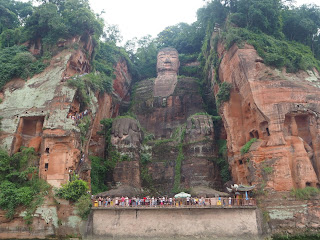Have you ever wondered what a single person is capable of achieving? A visit to the Leshan Giant Buddha might just expand your perspective and offer a glimpse into the extraordinary heights of human determination, devotion, and ingenuity.
I was deeply moved by the story our tour guide shared about the origins of this colossal statue. It began with a monk named Haitong, who lived during the Tang Dynasty. Saddened by the frequent shipwrecks and loss of lives caused by the violent waters at the confluence of three rivers - the Min River, Qingyi River, and Dadu River - Haitong was inspired to carve a massive Buddha into the cliff face, facing the turbulent waters. His hope was that the serene presence of the Buddha would calm the river currents and protect those who navigated them. Construction began in 713 AD.
Legend has it that when corrupt local officials tried to siphon funds from the donations Haitong had painstakingly collected, he refused. In a dramatic act of defiance, he is said to have proclaimed that they could take his eyeball but not a single coin meant for the Buddha. When challenged, he reportedly gouged out one of his eyes and offered it to the officials - who, utterly shaken, fled and never returned. Inspired by his sincerity and unwavering commitment, more donations poured in.
Sadly, Haitong passed away before the statue was completed. However, two of his devoted disciples carried on the work, and the project was eventually completed in 803 AD by the local governor—a full 90 years after it first began.
The Leshan Giant Buddha stands at an awe-inspiring 71m high. Its head alone measures 14.7m long and 10m wide, with 1,021 intricately carved hair buns. It remains the tallest Buddha statue in the world, towering 18m higher than the Bamiyan Buddhas in Afghanistan, which were tragically destroyed by the Taliban in March 2001.
Ironically - and impressively - the construction of the statue had an unintended yet welcome effect. The massive amount of rock carved out and dumped into the river below is believed to have altered the river currents, calming the turbulent waters and making the passage safer for vessels - just as Haitong had hoped.
In ancient times, a towering 13-story wooden pavilion was built to shield the statue from the elements. Unfortunately, it was destroyed during the Mongol invasions at the end of the Yuan Dynasty. Since then, the Buddha has been exposed to rain and sun, yet it continues to endure. A testament to the engineering skills of the time, the statue features a sophisticated drainage system carved directly into its body. Hidden channels and gutters still function today, helping to prevent erosion by diverting rainwater away from the stone surface.
Most tourists experience the statue by taking a boat ride from a nearby jetty. These boats typically spend just five to ten minutes in front of the Buddha - barely enough time to capture a few photos before being ushered along. With such a short window, it's no surprise that everyone scrambles to take as many shots as possible.
For those with more time and stamina, a more immersive experience awaits. Visitors can opt to be driven to the top of the mountain, where they join a winding queue to descend the cliffside path to the base of the statue. During peak seasons, the wait time can stretch to two or even three hours - but the close-up view of the Buddha's immense form is said to be well worth the effort.
In this natural formation, Wuyou Mountain represents the Buddha’s head, Lingyun Mountain forms the body, and Guicheng Mountain represents the feet. Stretching across an estimated 4,000m from north to south, with the head facing north, this sleeping figure appears serene and majestic, as if carved by nature itself. The discovery has added yet another layer of wonder to the already spiritually and culturally rich landscape of Leshan.
 |
| Abstracted from http://www.chinadiscovery.com/sichuan/leshan/ leshan-giant-buddha.html |
 |
Bamiyan Buddha before and after the destruction. Abstracted from https://en.wikipedia.org/wiki/ Buddhas_of_Bamiyan#/media/ File:Taller_Buddha_of_Bamiyan_
before_and_after_destruction.jpg |




No comments:
Post a Comment